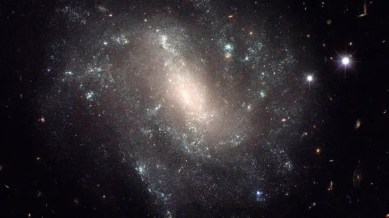Click here to join Express Pune WhatsApp channel and get a curated list of our stories
IUCAA astronomers use cool Mira stars to determine how fast universe is expanding
A variable star is one that doesn't shine with a constant brightness and scientists at Pune based Inter-University Centre for Astronomy and Astrophysics (IUCAA) utilized 40 oxygen-rich Mira variable stars located in 18 stellar clusters of our galaxy.

In a significant study, the most precise determination of the expansion rate of the universe was made using cool, giant variable stars ‘Mira’ in the galaxy as anchors for the first time.
A variable star is one that doesn’t shine with a constant brightness and scientists at Pune based Inter-University Centre for Astronomy and Astrophysics (IUCAA) utilized 40 oxygen-rich Mira variable stars located in 18 stellar clusters of our galaxy.
monthly limit of free stories.
with an Express account.
Led by professor Anupam Bharadwaj from IUCAA , the study also includes Nobel Laureate professor Adam Riess of the Space Telescope Science Institute and Johns Hopkins University as co-author.
When contacted, professor Bharadwaj told The Indian Express they used ‘Miras’ in the galaxy as anchors for the first time. “These cool stars helped us determine the precise cosmic expansion rate,” said professor Bharadwaj, the study’s lead author.
Mira, also known as Omicron Ceti, is a star that remarkably changes its brightness over time, in a regular pattern. With the variability first measured by astronomers in the 17th century, Mira was the first known example of a variable star—a star that doesn’t shine with a constant brightness.
“The name, Mira, means wonderful in Latin and it lived up to that name by becoming the prototype for an entire class of stars known as Mira variables. Mira variables are a type of giant star that go through regular cycles of expanding and contracting. These cycles cause their brightness to vary in a predictable way, typically over periods ranging from 100 to 1,000 days. These stars are relatively cool, with surface temperatures around 3,000 Kelvin (about half the temperature of the Sun’s surface), and they are in the late stages of their life,” explained professor Bharadwaj.
According to the study authors, the Hubble constant has been a focal point of debate in recent years, with different measurement methods yielding discrepant values, leading to what is known as the ‘Hubble tension’.
“This discrepancy suggests that the universe may be expanding faster in the present day than we would expect based on our standard models of cosmology. Scientists are actively trying to understand why this difference exists. It might point to unknown physics, or it could mean our current models need to be updated. Hence, discoveries like those involving Mira and other variable stars continue to play a key role in helping us unravel the mysteries of the cosmos,” study authors added.
According to an official statement issued by IUCAA, the research team monitored these Mira stars over an extended period, establishing their mean luminosities and pulsation periods. The European Space Agency’s Gaia mission played a key role by providing precise geometric distances to these star clusters, which are located between 13,000 and 55,000 light-years from Earth. “This allowed for an absolute calibration of the stellar luminosities of the Mira variables, providing a new level of precision,” the statement added.
Click here to join Express Pune WhatsApp channel and get a curated list of our stories